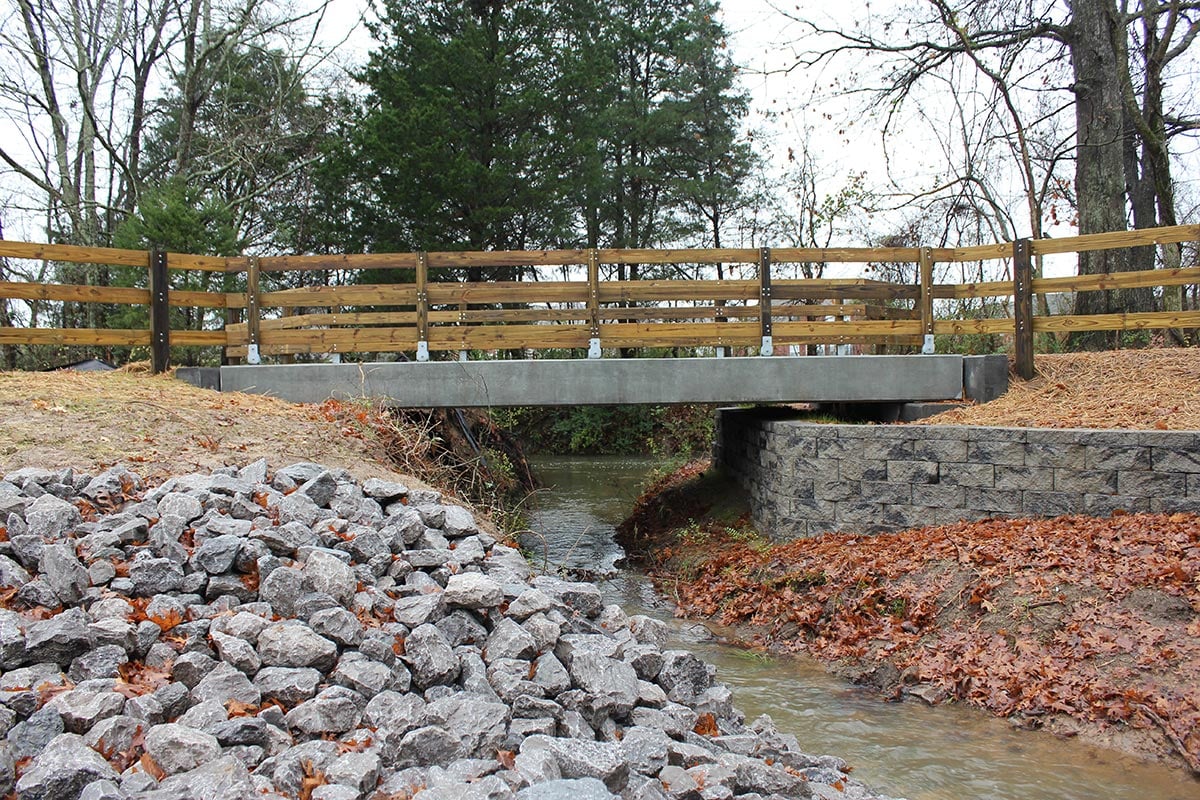While presenting the PermaTrak system to a new audience, we are often asked about the best practices used during the design process for pedestrian bridges.
Pedestrian bridges are typically built to allow people to cross a space, water, or a physical geographic feature. While designing a pedestrian bridge, there are seven simple considerations that will have a major impact on the long-term success of your project.
1. Determine Width
Establishing the planned width for the trail and pedestrian bridge is a basic starting point. Pedestrians and runners, walkers, bicyclists and others may use the pedestrian bridge. What size structure is required? A trail width may be as little as four to five feet; some reach out to 12 feet or more depending on the expected usage and location.
The “usable width” or “clear width” of a pedestrian bridge should match the width of the approaching trail. The clear width of the bridge then determines the design loading. AASHTO LRFD Guide Specifications for the Design of Pedestrian Bridges requires designing for the controlling case of a 90 psf pedestrian live load and a design vehicle. The weight of the design vehicle is based on the clear width of the structure. For example, narrower walkways with clear width less than 7 ft will be designed for a 5,000 lbs maintenance vehicle. Bridges with clear widths of 7 to 10 ft. are designed for an H-5 truck (10,000lb. Vehicular load). Pedestrian bridges over 10 ft wide are required by code to be designed for an H-10 truck (20,000lb vehicular load)
PermaTrak boardwalk pedestrian bridges have a minimum width of 3’-9”, and a current maximum width of 16’-0’’ for one tread. You can see examples here of photos of installed boardwalk projects with differing clear widths.
PermaTrak North America President Jason Philbin answers the question, “What is the limiting width of your PermaTrak pedestrian bridge system?”
2. Site Conditions
Once the designer identifies the width, they must then decide the site conditions the pedestrian bridge may encounter. Fairly flat terrain often does not call for anything more than following the site contours. Additional design considerations must be evaluated if the site includes water crossings, intersections, or steeper elevation changes.
Water Crossings:
When the pedestrian bridge spans over water bodies like rivers, streams, or ponds, the designer needs to account for the water flow, potential flooding events, and any environmental regulations related to water crossings. The bridge's alignment and foundation design should take into consideration the dynamic loads caused by moving water and potential scour around the bridge supports. The potential for floating debris impact should also be considered for the foundations and the superstructure as well as railings.
Steeper Elevation Changes:
In areas with significant changes in elevation, the designer needs to address the structural integrity and stability of the bridge. The alignment of the bridge and the type of foundation used should be suitable for accommodating varying slopes. Additionally, the design should consider the comfort and convenience of pedestrians when climbing or descending the bridge. ADA guidelines for maximum slopes, landings and grab rails should be considered and included in the design of the structure as appropriate.
Environmental Impact
The project may be subject to environmental regulations, especially in ecologically sensitive areas. The designer must assess potential impacts on wildlife, vegetation, and water bodies, and incorporate measures to minimize disruption to the ecosystem.
3. Geotechnical Analysis
Acquiring a geotechnical analysis is a prudent choice for learning site details for any bridge structure. The analysis will help you determine if deep foundations are necessary. If you have an idea of the surrounding soil condition, you can use this information to your advantage in the footing design.
A geotechnical analysis should be performed by a geotechnical engineer, who plays a vital role in conducting site-specific investigations and preparing detailed reports. Their work involves analyzing soil conditions, providing foundation type suggestions, and determining the design parameters that structural engineers need for their plans. It's crucial for designers to engage with geotechnical engineers during the initial stages of project planning to ensure a solid foundation for the construction and avoid potential issues later on.
Based on the estimated pier loads, geotechnical engineers perform varying investigations to verify the soil capacity and make recommendations for an appropriate foundation type.
Shallow Foundations (e.g., cast-in-place footings, pre-cast piers):
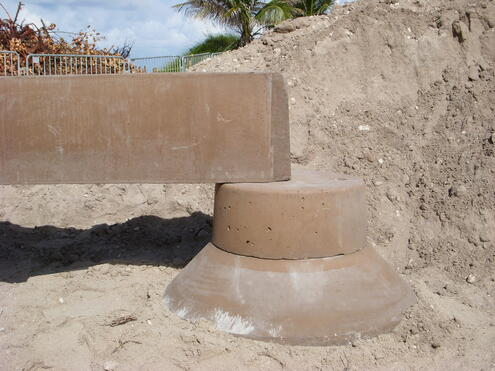
Geotechnical engineers conduct a site-specific investigation to determine soil conditions and provide an allowable bearing pressure in pounds per square foot (psf). During construction, the owner's inspector verifies the subgrade through tests like Cone Penetration Test (CPT) or visual inspection. If soil conditions differ from the investigation, the contractor consults with the Geotechnical Engineer and Structural Designer for reevaluation.
Screw Piles or Helical Piles/Piers:
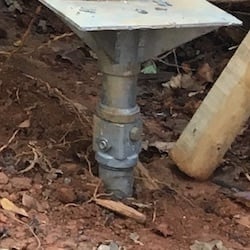
Prior to installation, the geotechnical report includes boring logs with blow counts (SPT N-values). Helical piles rely on soil bearing at each helix plate, so these values are essential for their design. Verification during construction can be done through static load testing to ensure the pile can withstand the design load.
CFA Piles (Continuous Flight Auger Piles) & Drilled Shaft:
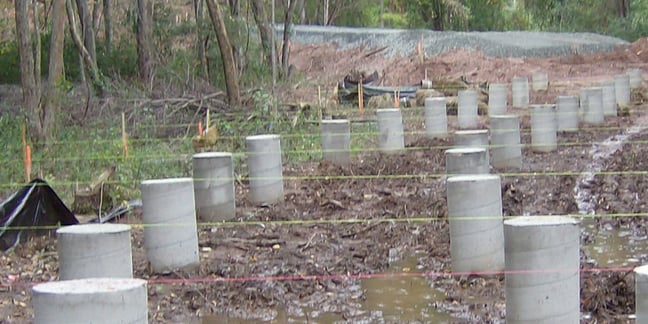
Geotechnical engineers provide allowable skin friction and/or end bearing pressure values for each soil stratum in the geotechnical report. The Structural Engineer uses this information to design the foundation's diameter and embedment depth. Contractors verify soil conditions during construction and install the foundation accordingly.
Driven Piles (e.g., Steel Pipe Piles, Round Timber Piles, FRP Piles, Steel H-Piles):
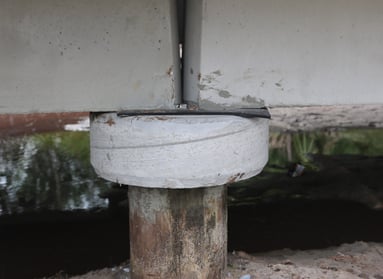
The Geotechnical Engineer provides allowable skin friction and/or end bearing values to estimate the pile depth. For driven piles, the Geotechnical Engineer provides driving criteria through WEAP analysis and/or PDA testing with CAPWAP analysis. The pile driver/installer uses this information to determine the number of pile driving hammer drops required to meet the design pile load.
Each type of foundation requires a specific geotechnical analysis to ensure its stability and effectiveness in supporting the boardwalk structure. The collaboration between geotechnical engineers and structural engineers is crucial to achieve a safe and successful pedestrian bridge construction project.
4. Abutment Plan
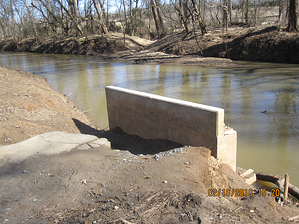
A clear span over a physical, geographic site feature can be as simple as developing an abutment plan for transitioning from the trail itself to a pedestrian bridge crossing. If soil conditions are favorable, a simple abutment plan will suffice.
If you are crossing water, more than an abutment must be considered for the design. Deeper foundations may be necessary to avoid the effects of scour at the site.
When designing a pedestrian bridge, PermaTrak typically uses two types of abutments for its precast boardwalk system: precast abutments and cast-in-place abutments.
Precast Abutments:
When the geotechnical conditions allow for a spread foundation, precast abutments are a commonly used transition in boardwalk design. PermaTrak produces these components off-site and delivers them along with other boardwalk elements, streamlining the installation process and minimizing disturbance to the project site. The installation requires light lifting equipment, making it efficient and convenient. Optionally, the design can include precast abutments with a cast-in-place concrete turn-down slab to transition to the approach trail.
Cast-in-Place Abutments:
In certain conditions, designers may opt for cast-in-place abutments, which are formed and poured in the field, sometimes simultaneously with the adjoining concrete path. This type of abutment allows for wider spacing between deep foundations in the boardwalk design, advantageous when avoiding obstacles like utility lines or natural features. However, installing cast-in-place abutments may take more time, and designers need to ensure that delivering wet concrete to the site is feasible without issues.
5. Permitting
Consider a longer span for water crossings, as it may help in the permitting process. The pedestrian bridge can be designed to span the waterway itself, the waterway banks or other environmental features at the site.
When permitting does not allow for disrupting the environment, the “in the dry” or “top-down construction” methods may be required.
Top-down construction is a technique involving the use of a compact and specialized machine equipped with specific attachments. This machine operates on top of the existing pedestrian bridge surface to install the next set of foundation components, beams, and treads.
Once a section is completed, the machine advances forward on the newly installed walking surface to proceed with the next segment. This incremental approach continues until the entire boardwalk is fully constructed.
A significant advantage of top-down construction is that the machine never drives directly on the wetland floor, minimizing its impact and reducing the overall footprint on the sensitive environment.
Top-down construction method using to build a PermaTrak boardwalk over wetlands on Shot Pouch Greenway, Sumter, SC
6. Safety
Any pedestrian bridge design must be well engineered to provide safe, long-term performance. Small bridges must provide a uniform deck surface, with elevation changes under ½’’ from one tread to another. Cracked, split or splintered deck surfaces will not meet ADA safety guidelines. Certainly boards with protruding screws, nails or other fasteners would be considered a tripping hazard. The pedestrian bridge should have safety design features, including a textured deck surface that will stand up to bikes, rollerblades and heavy pedestrian foot traffic.
A pedestrian bridge’s slip resistance is the ability of the deck's surface to provide sufficient traction and grip to prevent users from slipping or losing their footing while walking, running, or biking across the bridge. In essence, slip resistance ensures that the surface of the bridge is designed to minimize the risk of accidents or injuries caused by slipping, especially during wet or adverse weather conditions.
Various methods and materials can be employed to enhance slip resistance, including texturing the deck surface, using anti-slip coatings, or selecting materials with inherently slip-resistant properties. Designers and engineers must carefully consider these factors during the bridge's planning and construction to ensure that the surface offers a safe and reliable pathway for pedestrians and other users throughout its lifespan.
7. Durability
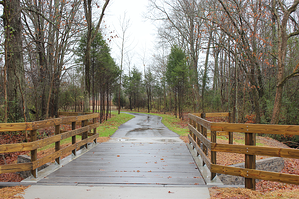
Many pedestrian bridges are located in the harsh environment found at outdoor recreation sites. Providing a durable, maintenance free pedestrian bridge can be a cost-effective solution to a difficult design challenge.
Choosing the right material is crucial to ensure long-lasting durability, especially in outdoor environments exposed to various elements. Let's compare three commonly used pedestrian bridge materials: pressure-treated timber, composite decking, and precast concrete, based on their durability characteristics.
Pressure-treated timber
While pressure-treated timber offers cost-effectiveness and ease of access for pedestrian bridge construction, its long-term durability raises concerns. Despite pressure treatment to minimize decay and warping, chemicals eventually leach out of the timber, posing potential damage to delicate ecosystems like wetland areas. Additionally, the moist nature of different environments can lead to swelling and rotting, further compromising the timber's durability. The growth of algae and moss on the surface creates slip hazards, requiring frequent maintenance efforts.
Composite decking
Composites, combining plastic and wood fibers, are often lauded as an eco-friendly alternative to timber, making them highly popular for outdoor residential decking. The most significant advantage of using composite decking on a wetland boardwalk lies in its biologically inert properties. This eliminates concerns of toxins or chemicals leaching into the surrounding soils over time. Furthermore, composite decking shares similarities with wood in terms of flexibility, allowing it to be cut and modified on-site during boardwalk construction. Contractors experienced in building timber boardwalks will typically find composite decking familiar and easy to work with.
Despite its merits, composite decking also presents notable challenges in damp and moist environments, affecting its overall durability. One substantial drawback is its vulnerability to mold and algae growth, especially in shaded areas. Despite containing plastic binders, most composite decking products incorporate wood flour or sawdust as a filler material, which absorbs moisture once the plank's outer protective shell is penetrated. Being classified as a non-"closed-cell material," moisture can enter through deck fasteners, such as screws or nails, which attach to supporting beams.
Precast Concrete
Concrete boardwalks are exceptionally durable and can withstand harsh weather conditions, heavy foot traffic, and exposure to the elements for decades. They are virtually immune to rot, insect damage, and decay, making them a long-lasting option with minimal maintenance requirements. Concrete boardwalks offer exceptional structural stability, even in challenging environments like coastal regions with saltwater exposure. While they may not possess the natural aesthetics of wood, concrete boardwalks excel in terms of durability and offer an excellent choice for high-traffic areas and locations with harsh climate conditions.
Your Next Steps as A Designer
In summary, the pedestrian bridge design process includes seven important considerations: trail width, site conditions, geotechnical analysis, abutment plan, permitting, safety and durability. Each item marked off the design checklist is another step towards a long-term successful project.
Reach out to PermaTrak for consultation and extensive support from the beginning stages of your project to its finished installation. Before commencing the design and construction document stages, get support from our team of Professional Engineers, registered in over 30 states.
During the design document stage, we collaborate closely with the designer, ensuring compliance with relevant design codes and live load requirements. This may include accommodating different loading scenarios, such as pedestrian loading of 90 psf, H5 truck (10,000 lb vehicle), H10 truck (20,000 lb. vehicle), or even heavier loads. We prioritize partnerships with specifying landscape architects or engineers, offering our expertise and support throughout the process.
In summary, the pedestrian bridge design process includes seven important considerations: trail width, site conditions, geotechnical analysis, abutment plan, permitting, safety and durability. Each item marked off the design checklist is another step towards a long-term successful project.

